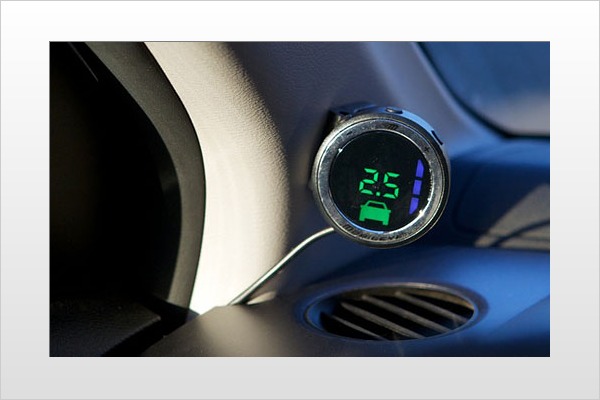
Collision-avoidance systems have become common on high-end cars and have even begun to appear on less expensive vehicles. Also known as advanced driver assistance systems (ADAS), they do everything from warning of vehicles in blind spots to detecting pedestrians in a car's path. Mobileye, a supplier of such systems to automakers, is now offering similar aftermarket technology, and one of the company's premier products is the CS-270.
Design
The CS-270 consists of a camera and dash-mounted display/control unit. The windshield-mounted camera detects and measures the distance to vehicles, lane markings and pedestrians and also incorporates an audible warning mechanism. The display/control unit indicates the presence and distance to vehicles ahead, when lane markers are crossed and if a pedestrian is in the vehicle's path. Suggested retail price of the CS-270 is $729, not including installation.
Since the Mobileye CS-270 is an aftermarket product, it doesn't have the seamless integration of similar features in production vehicles. Still, the nearly 2-inch-diameter and 1-inch-thick display/control unit is low-key and unobtrusive, yet also easy to see and access. And depending on the vehicle in which it is installed, the 2.6-by-1.5-inch camera housing can be concealed easily behind a rearview mirror.
Installation
We installed and tested the CS-270 in a 2008 Honda CR-V LX AWD at the Car Toys Gateway location in Portland, Oregon. A Mobileye technician did the installation, since at the time of the test the company was in the process of training installers at the retail locations where the CS-270 will be available. Obviously, this isn't a product designed for DIY installation, since it involves accessing various sophisticated vehicle systems and also requires specific software.
The installation took about three hours, including a final test-drive. The display was mounted on the far left side of the dash, next to the A-pillar, while the camera was installed behind the rearview mirror. It took us quite awhile to even notice the camera since it was so well hidden behind the rearview mirror.
On the Road
We tested the Mobileye CS-270 over several weeks, while driving highways, rural roads and city streets. The system automatically activates when the engine is started, and can be switched off by pressing and holding the Mobileye logo button at the top center of the display/control panel. The same button can also be used to change other settings (brightness level and warning-sensitivity levels) in conjunction with a plus and minus button on either side of the center button. They are also used to adjust the volume of audible warnings. Warning volume can also be adjusted on the camera housing.
A CS-270 feature that Mobileye calls headway monitoring and warning (HMW) displays your "headway," or the distance to the vehicle in front of you, in seconds relative to your speed and the speed of the other vehicle. This warning operates at speeds over 30 mph and is active when a green car icon is displayed and headway is less than 2.5 seconds. Once the system deems that the distance to the vehicle in front is unsafe, a single chime sounds.
The CS-270's forward collision warning (FCW) feature activates when the distance between your car and the one in front of it narrows dangerously. If the headway is less than 0.6 second, the car icon changes to red and the system issues a high-pitched alert. As with the headway monitoring and warning feature, front-collision warnings depend on vehicle speeds and the distance between the two vehicles. This means that warnings can come much quicker when speeds are higher, and that you won't get as many warnings in stop-and-go city traffic as you would when bearing down on a slower vehicle on the highway.
The CS-270's lane departure warning (LDW) comes into play when the vehicle crosses lane markers on the left or right side. That's when the system emits an audible warning distinct from the headway monitoring and forward collisions warnings, and the display shows a dotted line that corresponds to the side toward which the car has drifted. Similarly, when the system detects a pedestrian in front of the car, depending on the person's location and the vehicle's closing speed, the system flashes a silhouette of a person in the display and emits a distinct audible warning.
The pedestrian collision warning (PCW) works at speeds between 1 and 46 mph, and lane departure warning operates between 1 and 75 mph. The pedestrian warning is designed for daytime use, with limited operation at night. Similarly, the other three warnings can be affected by the amount of available light and lane markings.
The CS-270 worked as advertised in the Honda CR-V and performed well even in low-light situations, such as at dawn and dusk. In fact, it was accurate almost to a fault. As with factory-installed advanced driver assistance systems, the CS-270's warnings can make the difference between a near-miss and an accident — and maybe life or death — but they can also become bothersome. On production vehicles, features like the lane departure warning can be turned off, though others, such as forward collision, often cannot be disabled. Since it's an aftermarket device, you can turn down the volume of the CS-270's warnings or turn the whole system off if you desire.
Why You Want It
Mobileye's CS-270 makes advanced driver assistance system features that once could be found only on more expensive cars available for any vehicle. The system can provide peace of mind to anyone, and it's probably best for inexperienced drivers. But it can never take the place of common sense and careful car control.
The manufacturer provided Edmunds this product for the purposes of evaluation.